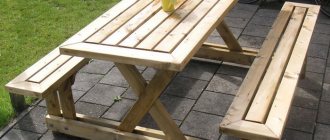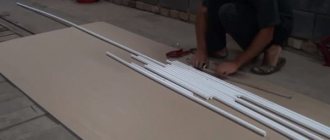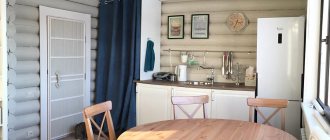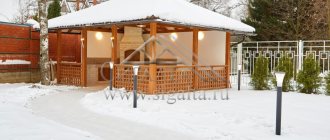Brick beds: features
Fencing flower beds and beds with bricks is considered a rather beautiful and durable solution for landscape design, whether in the countryside or in a suburban area. But you should know that in order to build such structures, you need to take into account the interesting features of stone structures.
It is believed that brick fences, especially high ones, are immovable, so they are erected as a permanent structure. Although if it is really necessary to move the structure, then such a structure will need to be disassembled entirely.
Such a structure consists of brick walls, reaching a height in some cases of up to 100 centimeters. In order for the structure to be quite stable, it is necessary to carry out the technology of constructing a brick wall, and under its base a solid foundation is made, in this case a strip foundation.
An important feature of brick fencing is the huge number of different shapes. They have the shape of a square, circle, rectangular, and also more complex, with a combination of different heights and any geometry. Such designs are perfect for any perfect plot of land and therefore have recently gained great popularity among gardeners and farmers.
What is the function of a fence for beds made of bricks?
Such a brick fence, as a rule, performs two main functions - practical and decorative. Brick beds are:
- Design solution for a personal plot. Brick beds very effectively and beautifully decorate absolutely all the plants on the plot of land. They are erected as a separate element, or as part of a general architectural and design solution.
- Performing protective functions of plants. Quite tall brick structures help protect cultivated crops from various pests, rodents and weeds. Also, thanks to them, the flowering period of plants noticeably increases, as well as their growth and fruiting.
- Functions of the territory separator, as well as its designation. Thanks to such structures, it is possible to divide the entire total area of the site into separate zones for planting berries, vegetables and ornamental crops. They also determine the location of various plantings and paths passing between them.
Parameters of raised beds
When installing high beds, you should follow some recommendations and take into account the following features.
Return to contents
Optimal height
- The height of the bed can be made to any height, even at waist level, the main thing is that it is not difficult to care for the plants and it is comfortable to work;
- If the soil on the site is fertile, a bed height of 15 cm is sufficient;
- For infertile soils, as well as for beds located off the ground, the height of the border should be at least 30 cm;
Scheme of arrangement and filling of a high bed
- A height of 30 cm is sufficient for most fruit and vegetable crops, but for potatoes the height should be higher - 40 cm;
- Warm compost beds should be at least 50 cm deep.
Return to contents
Length and width of raised beds
The length of the bed is not important; you can make it any length – as much as the site area allows. The only condition is that long beds need to be strengthened with additional jumpers or supporting posts. You need to pay closer attention to the width of the bed:
- The optimal number of rows of plants in a garden bed is no more than two. In this case, all plants receive enough light and air, making them easier to care for;
Drawing with dimensions of a high bed
- To easily reach the middle of the bed, it is better not to make the box too wide; the optimal parameters are from 90 to 120 cm.
Return to contents
Where to install a raised bed
If the nature of the soil is not particularly important for a smart garden bed, then sunlight is important for any crop. For planting, you should choose an area that receives direct sunlight for at least 5 hours. Before filling the bed, you should do the following:
- A construction mesh is nailed to the bottom of the box - it will protect the plants from rodents and moles;
- Then thick cardboard or geotextile is laid - weeds will not break through such a barrier, and the water will not stagnate.
Return to contents
What to plant
You can plant almost any vegetables, berries, herbs or flowers in high beds. On decorated beds, you can perform crop rotation every year, changing crops in places. Only plants such as sunflower or corn are not very convenient to grow in such boxes due to the tall growing stems.
Return to contents
What are the advantages and disadvantages of DIY brick beds?
Brick beds have their own personal advantages and disadvantages. And before you make such a structure on your site, be sure to familiarize yourself with them first so that there are no all kinds of unpleasant situations.
Here are the most important and well-known advantages of such structures:
- Quite neat, pleasant and aesthetic appearance.
- High level of durability and strength of this structure.
- Fairly rapid warming of the soil in spring.
- Quite easy to care for.
- Provides good protection of ornamental and vegetable crops from various pests and weeds.
- Significant increase in the fruiting period.
Such fences also have some disadvantages :
- The process of constructing a brick structure is quite complex.
- Impossibility of moving the structure.
- The soil dries out fairly quickly.
- Such fences are very attractive to cats.
Remember that a tall brick structure is considered a fairly solid structure that cannot be moved or altered. Therefore, before creating such a structure, pay special attention to its future location, shape, and size.
Recommendations for self-building
Now you need to figure out how to properly make raised beds on your site. There are several basic recommendations in this regard:
- After choosing a particular material for building such a vegetable garden, you should pay attention to various step-by-step instructions. For example, in the case of wooden boxes, you need to find out what compounds are best to treat this or that type of wood, and in the case of brickwork, find a suitable adhesive mortar for outdoor buildings;
- It is important to choose the optimal size of fencing. For example, for an ordinary plot with fertile soil, you can not raise the ridges higher than 20 cm to get a good harvest. In the case of “empty” land, on the contrary, it is worth raising the planting to a height of 30-50 cm. The width is selected depending on the selected crops - for carrots or cucumbers 90-100 cm is suitable, but for cabbage or large varieties of tomatoes the bed should be significantly larger wider;
- If the embankment will be placed on open ground, it is worth installing a metal mesh under it to protect it from large rodents. And cardboard sheets or old newspapers will help slow down the growth of weed plants;
- It is best to arrange plants in two or three rows. This will allow them to receive the optimal amount of moisture, oxygen and sunlight. Plantings that are too wide can lead to the death of crops planted in the center; moreover, they are more difficult to process;
- Additional equipment can be added to homemade boxes. For example, this could be a mesh that holds long stems or lush flowering plants, arches with a film that protects the bed from the influence of weather conditions, comfortable seating shelves;
- For regions with unstable weather, a clear plastic or film opening roof is an excellent addition to a raised vegetable garden. It will protect from rain, gusts of wind or intense sunlight.
So, by showing a little imagination in searching for materials and interesting shapes for vertical and raised beds, you can build a real work of art. Such a vegetable garden will not only please your family and friends with delicious home-grown vegetables or berries, but will also cause surprise and admiration for your neighbors!
How to make a bed out of brick - technology
There are two options for the technology of constructing such beds with your own hands - these are beds with high sides made of bricks and low fences of one or two bricks.
Any brick can be used for this. Either old, left over from renovation or construction, or new, specially purchased for these purposes.
Such structures differ mainly in their height and implementation methods. If you want to build a brick structure that is tall in size, then you should make a strip foundation. In addition, to install such beds you need to know the technology of building brick walls.
But the construction of fairly low beds made of brick is not a difficult process at all, which even a beginner can handle.
If you still decide to construct raised beds made of brick, then you may need the following items:
- Crushed stone, cement, sand.
- Bricks.
- Lumber to make formwork.
- Knitting wire, steel reinforcement.
- Construction level, tape measure, trowel, string, shovel, bayonet shovel. And also a bucket for mixing cement mortar.
Action plan for building a tall brick structure with your own hands:
- On a personal plot, the desired location is selected in advance and then pegs are driven in over the entire area of the future brick bed. A cord is stretched between these pegs. Thanks to this, the place for the future foundation becomes clear. And at the place where the cord is tensioned, you should dig a trench, at least 30 centimeters deep and about 20 centimeters wide, for such a design.
- After digging a trench, sand should be poured onto its bottom. Approximately the layer of sand should be 12-15 centimeters. This sand needs to be compacted and watered.
- Next, reinforcement is laid in two rows across the entire area of the trench, and formwork is made from old edged boards. At a height of about 10-15 centimeters from the soil level, the foundation is poured with concrete. After pouring, it must dry, so it is left to stand for about 2.5 weeks. And after the foundation has completely dried, the laying of bricks begins, and this is done from the corners.
- Such a brick structure can be of any height, from 30 centimeters to one meter. The top row of bricks can be covered with a plastic or wooden panel, as well as galvanized sheets.
If you follow this sequence of actions correctly, you can erect brick structures quite professionally. Well, after the brickwork has completely dried, they begin to fill it with certain layers in the following sequence:
- Protective layer (metal mesh),
- Active layer (wooden logs, plant bark with branches, paper scraps),
- Nutrient layer (cut grass with fallen leaves) and fertile soil.
Another way to make a bed out of brick is to simply line it with brick. This process is much easier than constructing a raised bed, as this method does not require pouring a foundation. And this also means that the ridge may well be moved to another site.
This fencing is made from bricks in the following ways:
- Place bricks on top of each other diagonally.
- Edging the ridge in one or a double row of bricks, without deepening.
- Lay the brick fence in one row with the recess.
The brick fence, which is laid out diagonally, has a jagged appearance and looks quite beautiful. A shallow trench is dug; its bottom is filled with sand, which should be compacted. Then such a structure can be completed in two ways: using liquid cement mortar, or not doing it.
The ridges that have a border with one row of bricks . And if the row-spacing is also lined with garden slabs, expanded clay or crushed stone, then this creates a truly beautiful look. In addition, the position of the brick can be completely different, and the structure can also be made in different shapes.
To erect such a structure, first outline the place where it will be located and its shape. Then they begin to dig a trench, this is if the brick is laid out high and buried halfway into the soil.
Although it can be laid directly on the soil. True, in this option it is necessary to make the masonry wider, flat. This will allow the border to be stronger, stronger and wider, so that it will not be able to move during agricultural work.
Why do you need a raised vegetable garden?
The main question that arises for gardeners who are not previously familiar with raised beds when they see photos of such structures is what they are needed for, is there a difference between them and ordinary plantings, and what are the pros and cons of raised beds. And those who have already seen this method of growing vegetables and berries in action will definitely begin to persuade the first to do the same.
What are the advantages of raised beds:
- You can grow any crops, regardless of the quality of the soil in your garden. To do this, each bed is filled with the soil composition that is suitable for a particular plant;
- It is possible to arrange a vegetable garden in this way even on the most uneven areas;
- At higher elevations, the soil warms up better, making it possible to start sowing in early spring, increasing the yield several times;
- High planting will help avoid plant death due to temperature changes;
- This design ensures good drainage: excess moisture during watering or rain will not linger on the beds, and the roots will not be damaged due to high groundwater;
- Economical water consumption - not the entire area is watered, but only specific ridges;
- The edges of the planting containers will protect the fertile layer of soil from being washed away and blown away by the wind;
- Thanks to the convenient location, it is convenient for older people to tinker with plants (fertilize the soil, process leaves, harvest, etc.), since they do not need to bend low;
- It is possible to place and decorate raised beds with your own hands so that they will become an effective addition to the landscape design of the site.
But besides the obvious advantages, such designs also have some disadvantages. They are connected primarily with the fact that plants in closed spaces need fertilizing more often than in open ground. There is also a possibility of the proliferation of various microorganisms and insects harmful to crops, but if you approach planting with all responsibility, this problem can be easily avoided.
Another nuance that is worth thinking about in advance is what type of bed, arrangement method and fencing material will be suitable in each specific case. There are budget options, when all the materials are collected on your own, and there are also more aesthetic and expensive ones with specially purchased devices for this purpose.
Brick beds in a greenhouse
In a greenhouse, fences can be made of completely different materials, but as for the sides made of brick, this is undoubtedly the most reliable and durable material. With a certain structure, it will be quite possible to sit on them, or use them as small tables for a variety of purposes.
To make such beds in greenhouses, use red, white bricks or paving stones. Such brick structures look great when the floor is laid with tiles, paving stones or large fractional expanded clay.
In a greenhouse, brick structures can have different heights. They also perform the function of a “warm bed” quite well and can tolerate high humidity remarkably well. Plus, their period of operation has an unlimited amount of time.
Such structures are made in a greenhouse according to the same scheme as in an open space. A foundation is provided for high brick beds even at the time of pouring the general foundation of the greenhouse itself. And low structures without a foundation are built after the entire installation and installation of the greenhouse, directly on site.










